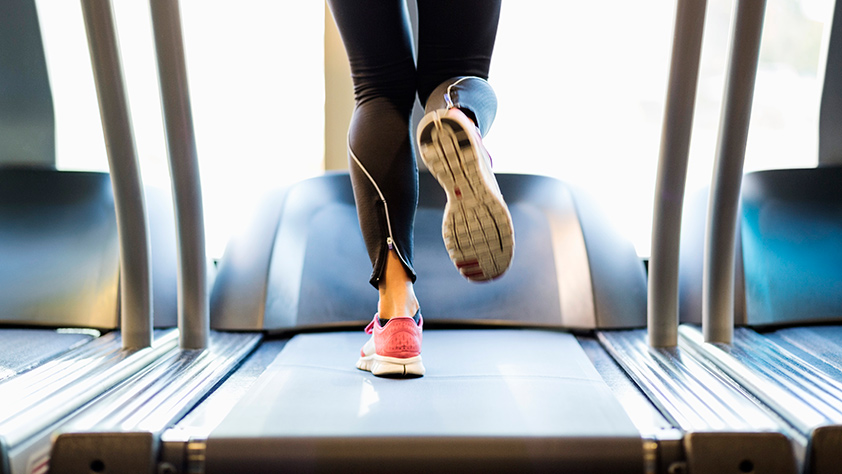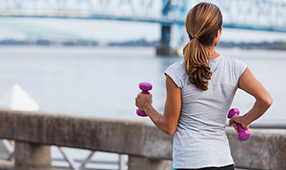Key takeaways
- Buying gym equipment costs money, requires space and makes working out a solitary venture.
- Gym memberships cost money in monthly fees and other charges, requires added time and effort to get there and makes working out more of a social venture.
- Many experts favor a combination of membership and home equipment.
Are you working on becoming more physically fit? You’re not alone: Americans spend more than $65 billion a year on fitness, according to Consumer Reports. Roughly one-third of us work out at gyms. The rest of us exercise at home, either for comfort or to save money.
With all the available options, how do you know if you should invest your exercise dollars in buying home equipment or in joining a local gym? Both sides have pros and cons.
Buying equipment costs money, requires space and makes working out a solitary venture. But you can choose exactly what you need and use it whenever you wish.
Buying a gym membership costs money in monthly fees and other charges, requires added time and effort to get there and makes working out more of a social venture. When you go to a gym, you typically have access to a wider range of equipment and services that you wouldn’t have at home.
Sorting through all of the options can be time consuming and challenging. There is no one-size-fits-all right answer—the key is finding the answer that’s right for you.
“The biggest question that needs to be addressed is accountability,” says Dallas-based certified master personal trainer Danielle Girdano, president of D’fine Sculpting and Nutrition, LLC. “Which will hold you to your goals better?”
Join a gym when...
- You can afford the fees
- You want classes
- You prefer exercising in a group setting or like social support
- You need a distraction-free environment
- A contract commitment helps you stick to your workout
- You want to use equipment you can’t afford or don’t want to own
- You want to try a variety of machines
“Some people are motivated by [going to] a gym,” says Kim Evans, a Grand Haven, Michigan, a fitness specialist with multiple certifications in group and personal training. The attraction could be the equipment, the classes or different types of gym facilities such as Pilates, Spin, CrossFit or Boot Camp, among others, she adds.
Benjamin Glaser, a spokesman and features editor for DealNews, the leading shopping comparison site, thinks “gym memberships are best for those who need classes” and “prefer a ‘destination’ to work out.”
Without his gym membership, former personal trainer Spencer X. Smith, now a digital marketing entrepreneur in Madison, Wisconsin, says, “I simply wouldn’t do the work.” The psychological associations are an important part of Smith’s workout habits and that helps him stay motivated. He starts mentally preparing his routine during his short drive over to the gym, so that when he gets there his workout happens automatically. While there, Smith says, “I don’t have any other options or distractions. I’m at the gym to do the only thing I do while I’m there: work out.”
Make sure the gym has the equipment you want to use and visit a few different days during the times you’ll want to work out to see how crowded it is, advises Joshua Duvauchelle, a Vancouver, British Columbia-based fitness coach and personal trainer certified through the American Council on Exercise. Is the equipment you want to use available or would you have to wait? Be sure the gym is open when you’ll be exercising, including weekends and holidays.
And before you sign a contract, know what your membership will actually cost. “Research by CNBC found that the typical person pays between $40 and $50 a month for gym membership, but don’t forget about the initiation fee,” which can be in the $100 to $200 range, Duvauchelle says, and incidental fees and add-on charges for classes or personal training. Make sure the contract length and terms are acceptable and find out if there’s a hefty penalty if the contract is terminated early.
Work out at home when...
- You prefer to exercise in private
- You can’t spare the travel time (to and from the gym)
- You’re motivated enough to stick to a home workout routine on your own
- You can afford and have the space for the equipment you want
- You’re concerned about exposure to communicable illnesses
- You don’t trust the facility’s lockers and privacy
Home fitness equipment is best for those who have the discipline to stick to a workout routine, but don’t have the time or money for a gym membership, says Glaser.
Ask yourself three questions, advises Drew O’Connell, master fitness trainer and founder-president of Now Fitness, an online-only gym, and creator of the Now Body Fitness 15 Minute Bodyweight DVD series. Are you willing to pack your gym clothes and drive to the gym every day? Are you willing to shower at the gym before work? Does the gym have a class that will keep you motivated? “If you answer ‘no’ to any of these questions,” O’Connell says, “then working out at home is a great option for you,” he says.
When you shop, don’t spend hundreds or even thousands of dollars for large pieces of home-exercise equipment, Glaser cautions, “especially if you are just starting.” Before you invest a lot of money, make sure you’ll use the equipment often enough to justify the cost and choose quality products that will last.
Blend a bit of both
Many experts favor a combination of membership and home equipment.
For example, Evans says, educators could take advantage of facilities such as a gym, workout area or fitness class on campus instead of buying a gym membership, and then do a different (no equipment) workout at home, too. She does that herself. “I belong to an aquatic center to swim,” she says, and does all her other workouts in her home space or outside.
Whatever you choose, Evans says, when “you find something you like, you will stick with it.”












